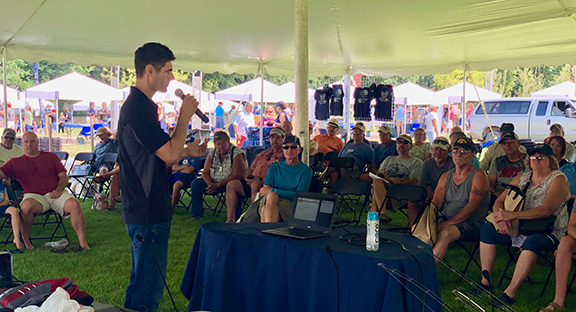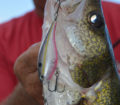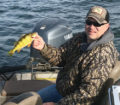By Steve Weisman

(photo by Steve Weisman) Pure Fishing’s senior bait development engineer Dan Spengler shares his knowledge to fishing enthusiasts at the Okoboji Blue Water Festival.
At the Okoboji Blue Water Festival, fishing enthusiasts had the opportunity to attend the fishing seminar put on by Pure Fishing’s senior bait development engineer Dan Spengler. Entitled “The Science of Fishing Lures,” Spengler’s goal was to share his passion for hardbait design and share with those in attendance the art/science of creating a top working hardbaits and how to fish these baits.
Spengler began by saying, “There is nothing cooler than to catch fish on a bait you have made yourself.” In some respects, Spengler is a self-taught hardbait engineer. “I began making baits from the time I was nine years old and continued to do that through college.” He designed, developed and tested over 100 lures while in college. Yes, even as he pursued his masters in Fisheries at South Dakota State, Spengler continued to design his own lures. The lures I developed in college were a lot more sophisticated than what I made at age nine, “but what do expect from a nine-year-old kid!” Spengler recalled his first lure, an in-line spinner made from a paper clip, bullet sinker and Indiana blade. “I watched a lot of MacGyver when I was a kid,” Spengler joked.
Fate then stepped in. Spengler had just been offered a fisheries biologist job in Pierre, SD, but on the way home from the interview, Dr. Keith Jones, head of Berkley research, offered Spengler the chance to join the Berkley team as a bait development engineer. A youngster’s dream had become reality. “Berkley is the place where science meets fishing lures. Our philosophy is letting the fish tell you what they like,” said Spengler. With this background in mind, Spengler began to discuss the lure development process.
“The best lures come from a blend of science, research, passion and time. The product development cycle is a two to three-year process.” Spengler noted, “The process starts with the concept asking such questions as what do we want this lure to do? What depth? What action? Any sound? Casting ability? Buoyancy? Shape and size?” Everything revolves around finding what fish like. It is a painstakingly slow process to reach the public. Amazingly, many never reach production because they just don’t stand up to the tests. Even to the very end, engineers are tweaking and fine-tuning action and colors.
Berkley engineers have the good fortune of having laboratory testing facilities. A casting lab, a pool 60’ x 13.5’ x 6’ provides an angler viewpoint of a fishing lure and how the lure feels during retrieve. There is even a cave for underwater view. One of Spengler’s favorites is a flow tank that allows the human eye to see exactly how a lure moves and study action. Finally, there is the race track test pool, where naïve fish are introduced to a hard bait, soft bait or jig. These fish have never seen a lure before, so it’s a true test of what fish prefer in terms of shape, size, color and action. Some lure shapes and actions don’t perform well and won’t make the cut! The one’s that pass the fish test move on to the next step, which is field testing.
Again, this is another example of letting the fish tell the engineers what they like. Fishing pros are also brought in to be part of the design and testing process. After a lure passes the lab tests, the baits are subjected to field tests (some lasting a year) across a variety of waters, which includes getting the lure in the hands of fishing pros and Berkley Product Team. Spengler himself gets the opportunity to field test these baits across the Midwest.
If a bait successfully passes all our tests, then the product is ready to launch to the public where it’s taken to trade shows, big media events and product advertising. An example of a time tested and successful hardbait is the Flicker family. On the tournament trail, the Flicker family has led to 40 major tournament victories, 5 championships and countless top 10s.
One of Spengler’s pride and joys is the Berkley Shallow Cutter 90. Those in attendance all received one of the Shallow Cutters. Spengler, himself, recalled one epic night where he caught eight walleyes over 27 inches in just three hours with the Shallow Cutter 90. Spengler noted, “This is the perfect walleye jerk bait that includes a high pitch rattle. It’s versatile and can be fished fast or slow.” From his hours of experimenting, top techniques include a twitch/rip pause retrieve with either a long or short pause. In the wind, snap up and pause. Another option is to twitch and slow drag about a foot or, reel up and repeat. Sometimes a straight retrieve is the answer. But the key is to vary your technique. “I always let the fish tell me what they like when I’m on the water.”
Yes, Spengler knows his Berkley baits, and he could write a book about all of the baits he has been a part of (not enough room here-lol) Something important to remember is that it’s not one action, or two specific actions – it’s a combination of all the “right” actions that make Berkley baits CATCH MORE FISH. He adds, “Think differently on the water – be innovative – think like a fish! And if there’s a youngster out there that has the same love and dream for designing lures that I did, follow that dream. It is possible!”













